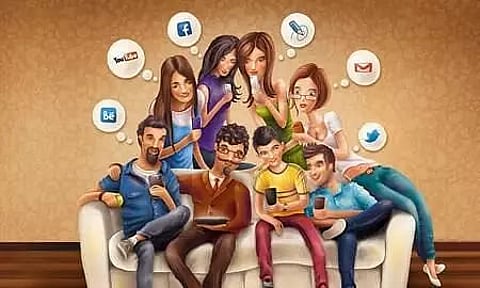
- Home
- Live Blog
- Breaking News
- Top Headlines
- Cities
- NE News
- Sentinel Media
- Sports
- Education
- Jobs

Ishan Talukdar
(ishantalukdar666@gmail.com)
Social media is the collective of online communications channels dedicated to community-based input, interaction, content-sharing and collaboration. The general purpose of this review is to provide detailed information about the impact of social media on society. A lot of studies indicated that social media has both positive and negative outcomes. Some of the positive outcomes are, for example, Socialization and Communication; enhanced learning opportunities and accessing of health-related information. On the other hand, depression, anxiety, catfishing, bullying, terrorism and criminal activities are some of the negative sides of social media on societies. Generally, when peoples use social media for appropriate purpose and predetermined goals the outcome will be positive and the reverse is true for negative side effects. In order to decrease and save the societies from its negative side effects and encourage the positive ones, all concerned will have to work collaboratively.
Several researchers have proposed a new phenomenon called 'Facebook depression', which is defined as depression that develops when individuals spend an excessive amounts of time on social media sites, such as Facebook, and then begin to exhibit classic symptoms of depression. Seeking acceptance and staying connected with peers is an important element of social life. However, the intensity of the online world, which requires constant engagement, creates a factor of self-awareness that may trigger depression in some people. As with offline depression, people who suffer from Facebook depression are at risk for social isolation and sometimes turn to risky Internet sites and blogs for 'help' that may promote substance abuse, unsafe sexual practices, aggressive and self-destructive behaviours.
In addition to being a source of depression and anxiety, social media is also a common source of stress to its users. A survey performed on 7,000 mothers found that 42% of mothers using the photo-sharing sites reported occasionally suffering from stress. Social media causes depression and anxiety in two ways. Chronic stress causes depression and anxiety. Being constantly alert for new social media messages, to your instinctive fight or flight limbic system, is the same as being on continuous alert for predators, which causes a release of the stress hormone cortisol. Primarily, social media promotes putting up a facade that highlights all the fun, excitement and success we seem to enjoy, but tells very little about where we are struggling in our day-to-day life on a deeper level and leads to experience of false intimacy. So to fit in, in our profiles we try to portray perfectly happy and trendy facades because that's what we see others doing. As a result, our profiles reflect how we want to be perceived, rather than showing an honest picture of who we really are.
When people focus so much time on social media networks, real life relationships begin to suffer. In doing this our more important relationships with our loved ones and close family members suffer because more of our time and effort are put into the illusion of social media. The term 'catfish' describes people who create fake social networking profiles, and 'catfishing' is the process of befriending strangers online while using a fake or stolen identity. It is a deceptive act and it has ruined marriages, relationships and the emotional well-being of many people.
Cyber bullying has become a major issue among youths in the last couple of decades, as it allows its perpetrators to post things in front of their peers and humiliate them. Bullying is defined as an aggressive act that is carried out by a group or an individual repeatedly and over time against a victim who cannot easily defend him or herself. With the use of Internet and mobile phones, a new form of bullying has emerged, often called 'cyber bullying'. In cyber bullying, aggression occurs via electronic method, via the Internet and especially through social media.
Another dangerous aspect of social media is the rapid adoption of this medium by terrorists groups. In the last couple of decades, incidents of Islamic terrorism have occurred on a global scale, not only in Muslim-majority countries, but also in Europe, Russia, and the United States. Terrorism has been using social media for their benefit for gathering information, for recruiting members, for fund raising, and for propaganda schemes. Ever since then, monitoring the use of the Internet and online platforms use by terrorist groups has skyrocketed from 12 to over 9,800 terrorist web sites according to reports.
Generally, social media has two side effects: positive and negative. The positive sides are, when peoples use social media for appropriate purpose and predetermined goals, and the reverse is true for negative side effects. Nowdays due to technology advancement, especially smart cell phones and mobile data, even elementary school students are using social media. So in addition to its benefits, these students might share its burdens, too, according to the researchers.